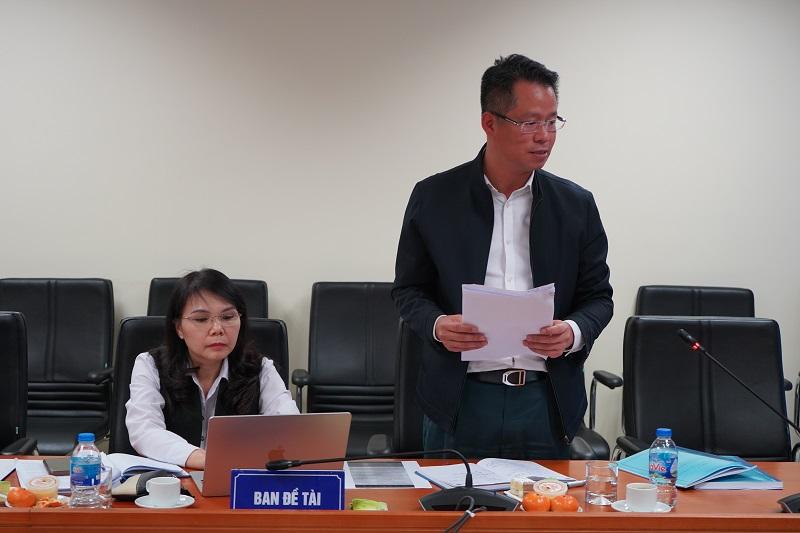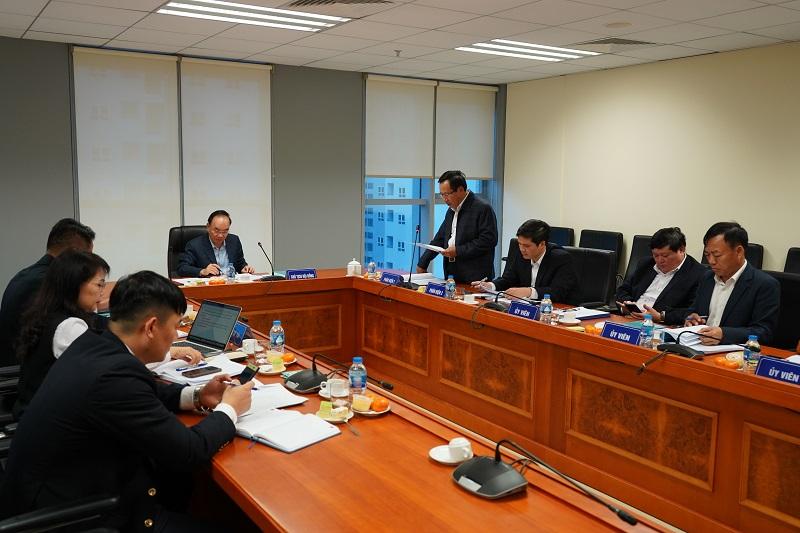Developing the criteria for materiality and risk assessment when auditing the budgets of ministries and central agencies performed by the State Audit Office of Viet Nam (SAV)
On December 5th, 2022, the Audit Training Institute accepted the ministry-level scientific research "Developing the criteria for materiality and risk assessment when auditing the budgets of ministries and central agencies performed by SAV” as co-leaded by MSc. Truong Tuan Ngoc, Regional State Audit Office No. VI and MSc. Nong Thi Lich, Specialized Audit Department No. II. Prof. Dr. Doan Xuan Tien as Chairman of the Acceptance Council.

The research management board
The research management board reported that risk-based audit is inevitable and objective, which has been widely performed by SAV through the promulgation of a new system of auditing standards, training activities, the promulgation of new auditing processes and documents, application in practice, etc. Since the state budget in general and budgets of ministries and central agencies, in particular, are the regular and main objects of SAV, the application of this approach is obvious for those kinds of budgets.
However, in practice, the application of risks and materiality assessment criteria has revealed a number of shortcomings such as the criteria not reflecting the nature of the auditee's activities nor being uniformly applied. The materiality level determined is not suitable with the operation scale of the auditee.
Furthermore, changes in the audit environment and legal regulations significantly affect the presentation and disclosure of information while auditing budgets of ministries and central agencies. The risk of fraud in the presentation of disclosures of information increases, especially in high-risk areas of activity. Therefore, developing the said criteria is an urgent requirement, bringing benefits to the budget audits of ministries and central agencies - a key auditing field in the operation of SAV at present. Even if the integration of audit contents within an audit increases due to the needs of stakeholders and society, the focus of audit on risk areas also promotes advantages to achieve better audit efficiency and effectiveness.
The selection of the topic “Developing the criteria for risk and materiality assessment when auditing the budgets of ministries and central agencies performed by SAV” aims to develop a set of criteria for appropriate ministries and central agencies, using the risk assessment-based audit approach for wide and consistent application. SAV could solve problems arising from auditing practice that still exist in the budget audit of ministries and central agencies. The resolution of the above-mentioned issues in a systematic manner, following the process of an audit with integrated audit contents in order to improve efficiency and effectiveness.
The research is urgent to serve the audit and improve the audit quality, in line with SAV's development roadmap according to the approved strategy.
In addition to the introduction and conclusion, the research is divided into 3 chapters: Chapter I - Overview of the audit approach on risk-based and materiality audit when auditing the budget of ministries and central agencies; Chapter II - Actual situation of applying risk-based and materiality when auditing budgets of ministries and central agencies; Chapter III - Developing a set of criteria for risk and materiality assessment when auditing the budgets of ministries and central agencies performed by SAV.
The research uses the method of synthesis and analysis to draw up the theory and practical issues on the criteria for materiality and risk assessment in risk-based audit, methods of document evaluation, observation and verification to research, summarize the current situation in order to clarify and highlight the current status of research problems and clearly identify the causes as a basis for proposing solutions.

The Acceptance Council
According to the assessment of the Acceptance Council, the research is highly practical with scientific and theoretical significance. The summarizing report on research results was presented in a clear, coherent, logical manner with layout, tables, diagrams suitable for each area being covered. The research has set out the basic theoretical issues of the criteria for risks and materiality assessment in auditing budgets of ministries and central agencies, as well as synthesized, analyzed and evaluated the actual application of those criteria in the central budget audit. The judgments and assessments are based on reality and objectively and scientifically reflect SAV's actual situation. Orientations and proposed solutions are realistic and feasible in terms of developing criteria for risks and materiality assessment in budget audits of ministries and central agencies. The research results could provide practical bases for SAV's specialized audit departments (in charge of budget auditing) and governing advisory departments to refer to in making decisions on the operation and administration of auditing budgets of ministries and central agencies.
The Acceptance Council suggested that the research committee consider adding research scopes; concisely editing Chapter I to ensure a balanced chapter layout; considering and editing the phrase "risks and materiality assessment" into the phrase "risks assessment, materiality determination" to be theoretically and conceptually correct, while also deeply analyzing and clarifying the shortcomings and limitations as there is no set of criteria in Chapter II. On the basis of the presented content, the part of developing the set of criteria in Chapter III needs to be analyzed more closely and logically in line with the theory and reality in previous Chapters.
The Acceptance Council highly appreciated that the research committee proposes specific criteria for each field such as revenue, recurrent expenditure, investment expenditure, and each type of auditee. However, for higher quality of the research, there should be notes for each specific sector, depending on the characteristics of its management of each ministry as mentioned in Chapter I. In addition, the development of criteria for auditing the budget settlement reports of ministries and central agencies would also be an important content that can be applied in the practice of auditing activities.
To conclude, Chairman of the Acceptance Council, Prof. Dr. Doan Xuan Tien highly appreciated the efforts of the research committee. The research has invested seriously in systematizing theoretical issues, assessed the actual situation and developed criteria for assessing risks and materiality when auditing the budgets of ministries and central agencies performed by SAV. The research has scientific value in terms of both theory and practice in auditing activities at SAV. The research management board should consider and obtain suggestions from members of the Acceptance Council to finalize the research. The research marked 80.4 points (over 100 points) and was graded as good by the Acceptance Council./.

